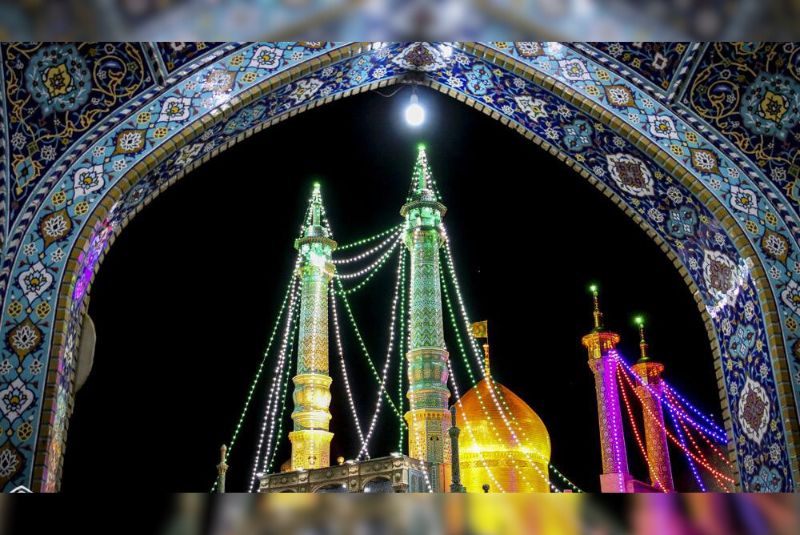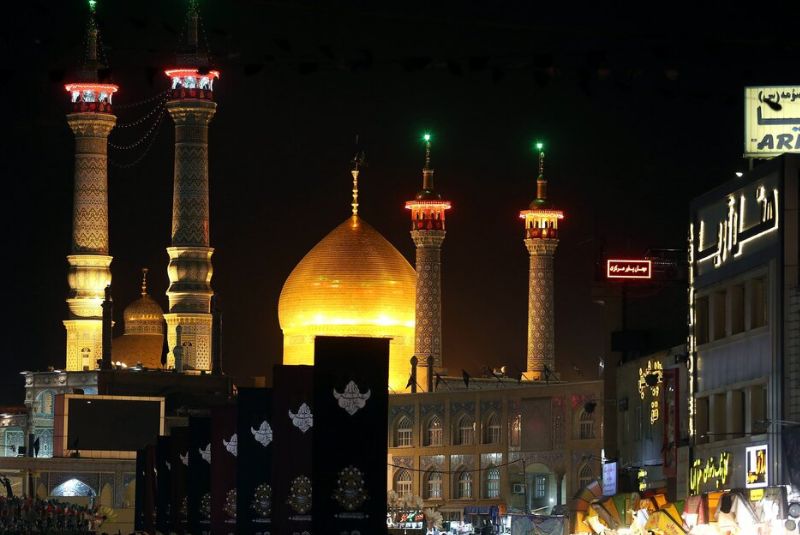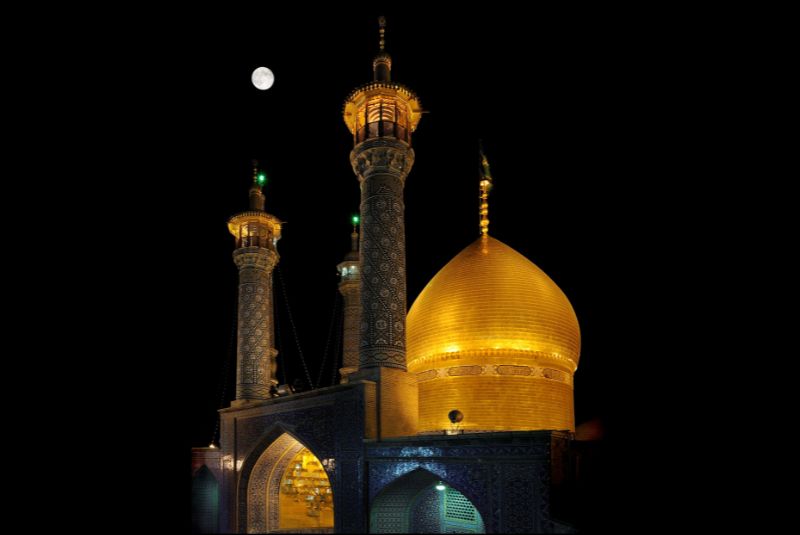Fatemeh Masoumeh Shrine Pilgrimage in Qom
The Hazrat Masoumeh Shrine, located in Qom, Iran, is a significant religious and cultural site. Dedicated to Fatima Masoumeh, the sister of the eighth Imam of Shia Islam, Imam Reza, the shrine attracts millions of pilgrims annually.
The complex not only serves as a place of worship but also as a testament to Islamic architecture and art, showcasing over a millennium of diverse styles. It houses several mosques, courtyards, and a museum, each rich with historical and artistic value.
Fatemeh Masoumeh Shrine History

Hazrat Fatemeh Masumeh, born in 790 AD, was the daughter of the seventh Shia Imam, Imam Musa Kazem, and the sister of the eighth Imam, Imam Reza. Known for her piety and deep knowledge, Bibi Masuma embarked on a journey to visit her brother in Marv in 201 AH but fell ill and passed away in Qom in 816 AD. Her burial site, initially marked by a simple canopy, gradually transformed into a significant pilgrimage destination.
The Journey to Qom
Fatemeh Masumeh's journey to Qom in 201 AH was driven by her desire to visit her brother, Imam Reza, and propagate Shiism. Along the way, her caravan faced hostility in Saveh, leading to a battle that resulted in the death of some of her companions. Subsequently, she was warmly welcomed by the people of Qom and spent her final days in the house of Musa bin Khazraj. Fatemeh Masumeh passed away at the age of 28 and was buried in Bagh Babolan, Qom.
The First Building of the Shrine
Upon her passing, Musa bin Khazraj, a prominent figure in Qom, dedicated his garden, Babolan, for her burial. A canopy made of Buriya was initially placed over her grave by the Ash'aris. By the mid-3rd century AH, Zainab, daughter of Imam Javad, constructed a dome over the grave. Over time, two additional domes were built nearby to accommodate the burial of other Alavi women. In 350 AH, the ruler of Qom, Abul Hasan Zeyd bin Ahmad bin Bahr Isfahani, expanded the tomb and added a larger door.
Seljuk, Timurid, and Mozaffarian Eras
In 447 AH, Abul Fazl Iraqi, a Seljuk Amir, initiated the construction of a new shrine and dome, completing it in 457 AH. Remarkably, the shrine survived the Mongol invasion, and Sultan Muhammad Al-Jayto later contributed to its construction. In 605 AH, Amir Muzaffar Ahmad bin Ismail of the Muzaffarian dynasty commissioned master tile maker Muhammad bin Abi Tahir Kashi Qomi to create intricate tiles for the shrine, which were installed in 613 AH.
Safavid Era
The shrine's glory was further enhanced during the Safavid period. Shah Ismail I transformed the mausoleum into an octagonal structure with mosaic tiles and built a porch with two minarets. Shah Tahmasb I added a brick shrine with marble inscriptions and colorful tiles. In 1077 AH, Shah Safi constructed the women's court, now known as the Tabatabai Mosque. Despite suffering during the Afghan attack, the shrine retained much of its splendor.
Qajar Era
Significant restoration and construction activities resumed during the Qajar dynasty. Fath Ali Shah ordered the construction of a gold-plated dome in 1218 AH and a silver shrine in 1230 AH, which was replaced in 1280 AH due to wear. He also marbleized the shrine floor, gilded the minarets, installed a gold door, and initiated mirroring work on the shrine's walls. Naser al-Din Shah further restored the minarets and added new porticoes. The foundation of the new great court was laid in the late 13th century AH.
Post-Islamic Revolution
Following the Islamic Revolution, extensive development and restoration efforts were undertaken. The shrine administration oversaw maintenance and care, including replacing the golden clay dome in 2001. By 2005, a new dome was unveiled, and in 1998, the shrine's interior walls were decorated with green marble. These efforts have ensured that the shrine remains a significant spiritual and cultural center.
Fatemeh Masoumeh Shrine Architecture

The architecture of the Hazrat Fatemeh Masumeh Shrine is a testament to the rich legacy of Islamic art and culture. With over a millennium of history, the shrine showcases a blend of various Islamic architectural styles, most prominently the Isfahani style. This style is characterized by intricate moqrans work, attention to neighborhood integration, exquisite tile work, mirror work, towering minarets, and detailed inscriptions. The shrine's architecture not only reflects its religious significance but also creates a deeply spiritual atmosphere.
Dome and Minarets

The dome of the shrine is shaped like a hat, symbolizing respect for the elders, a custom from the past. The minarets are designed to resemble hands raised in prayer, emphasizing their role as guardians of the shrine. The smaller minarets surrounding the main dome and various courtyards further enhance this imagery.
Courtyards and Porticoes

The shrine's courtyard, initially composed by Mirza Ali Khan Atabek during the reign of Naser al-Din Shah, has been adorned with tiles and mirrors over time. The architectural patterns and arrays are so captivating that they draw the admiration of every visitor. The courtyards and porticoes within the shrine complex are significant elements of its architectural grandeur.
Different Parts of the Shrine
- Tomb: The tomb of Hazrat Fatemeh Masumeh measures 2.95 by 1.20 meters and is 1.20 meters high, covered with exquisite gold tiles. A wall decorated with mosaic tiles surrounds the shrine, which is now enclosed by a silver mesh dating back to 950 AH.
- Porticos: The shrine has six porticoes, each adorned with various Islamic arts and inscriptions. These porticoes were constructed in different eras:
- Western Portico: Built in 1236 AH by Mohammad Taqi Mirza Hessam al-Saltaneh, this portico replaced the guest house built by Shah Tahmasb.
- Eastern Portico (Mirror Portico): Constructed in 1130 AH by Ali Asghar Khan Atabek, this 23-meter portico is 5 meters high and 3.5 meters wide.
- Portico and Dome of Shah Abbas II: Built in 1077 AH by Shah Suleiman, this portico features a dome with 16 sides and inscriptions by Mohammad Reza Emami.
- Shah Safi Portico (Women's Shrine): Constructed in 1052 AH by Shah Abbas, this portico has a double-covered dome and houses the tomb of Shah Safi.
- Shah Suleiman's Portico and Dome: Built by Sultan Hussein in 1107 AH, this portico contains the tombs of Shah Sultan Hussein and Shah Suleiman.
- Tabatabai Portico and Dome: Built between 1360 and 1370 AH by Haj Agha Mohammad Tabatabai, this portico is triangular in shape.
Courtyards
- Sahn Atiq (Sahn al-Kadim or Sahn Imam Hadi): The first square sahn with three porches was built by Shah Begum Safavi in 925 AH. It later became an irregular octagonal shape. Today, the Atiq court has seven porches, adorned with Islamic art decorations.
- New Court (Imam Reza Court or Atabaki Court): Constructed from 1295 to 1303 AH by Mirza Ali Asghar Khan Atabak, this courtyard is known for its mirror porch, an architectural masterpiece by Hassan Memar Qomi.
- Sahib al-Zaman Courtyard: Covering an area of about 8,000 square meters, this courtyard features Quranic inscriptions and is decorated with Banaei and Kufi script.
Fatemeh Masoumeh Shrine Mosques

Azam Mosque
The Azam Mosque, also known as the Ayatollah Boroujerdi Mosque, was built in 1998 by Seyyed Hossein Tabatabai Boroujerdi. It is located next to the mausoleum of Hazrat Masoumeh. Initially an independent structure, it was later incorporated into the shrine complex during expansions. The mosque features a beautiful blue dome, approximately 24 meters high, designed to complement the golden dome of Hazrat Masoumeh. The architect, Hossein Lorzadeh, designed the mosque with three balconies, making it a prominent teaching center for the Qom seminary. The western side of the mosque houses a library with over 100,000 printed books and 7,000 manuscripts, making it one of Iran's most reliable libraries for manuscripts.
Balasar Mosque
The Balasar Mosque is in the ancient courtyard west of the holy shrine and is the oldest and most beautiful part of the shrine complex. It was built above the head of Hazrat Masoumeh during the Safavid era, hence the name "Balasar." Originally a guest house, it underwent significant changes during the Qajar period. The mosque is a revered place for prayer and worship, with many narrations emphasizing its spiritual importance. Notable Shia clerics, including Ayatollah Muhammad Taqi Behjat and Ayatollah Muhammad Hossein Tabatabai, are buried here. The mosque also features some of the shrine's oldest and most beautiful tiles, created by Mohammad bin Abi Taher Kashi Qomi during the Mozafarian era in 630 AH.
Tabatabai Mosque
The Tabatabai Mosque, built between 1360 and 1370 AH, is located in the south of the Holy Mosque, replacing the former women's court. Founded by Hajj al-Islam Haj Agha Muhammad Tabatabai, it is notable for its high dome and significant religious role within the shrine complex.
Shahid Motahari Mosque
The Shahid Motahari Mosque, built in place of the former museum, hosts most of the shrine's religious ceremonies. Dedicated to Morteza Motahari, a prominent Iranian cleric and philosopher, it plays a crucial role in the shrine's religious and cultural activities.
Museum of the Holy Shrine of Hazrat Masoumeh (Astan)
The Museum of the Holy Shrine of Hazrat Masoumeh, established in 1935, is one of Iran's oldest museums. Initially, artifacts were scattered around the shrine until the museum provided a dedicated space. After a temporary closure in 1974, it reopened in 1982 next to the Feyziyeh School, expanding from 500 to 1,200 square meters. The museum features a rich collection of items like cloth weaving, painting, metalwork, sculpture, gemstones, inlay work, calligraphic panels, glasswork, and cursive Qurans, donated by kings, admirers of Ahl al-Bayt, and art enthusiasts.
Fatemeh Masoumeh Shrine Library
Founded in 1952 by Seyyed Abulfazl, the Hazrat Masoumeh Shrine Library began with a donation of 1,500 books. It has since grown into one of Iran's major public libraries, located in the courtyard of the Great Prophet. The library spans 12,000 square meters over four floors, housing a vast collection of printed, stone, calligraphic, and lead-printed books. It offers separate halls for men and women, serving as a significant resource for scholars and the public.
Fatemeh Masoumeh Shrine Religious Significance

The shrine holds immense religious significance for Shia Muslims. It is considered a place of great spiritual power, where prayers are believed to be especially potent. Pilgrims visit the shrine to seek blessings, fulfill vows, and engage in various religious rituals. Major religious ceremonies and commemorations are held here, attracting devotees from across the globe. The shrine's influence extends beyond religious practices, playing a crucial role in the cultural and social life of Qom.
Visitor Information

The Fatemeh Masumeh Shrine location is in the city of Qom, which is easily accessible by road and rail. The shrine is open to visitors 24 hours a day, seven days a week. Visitors are required to dress modestly and adhere to the shrine's etiquette. Guided tours are available, providing insights into the shrine's history and significance. For those interested in deeper exploration, the shrine complex also includes a museum that showcases religious artifacts and historical exhibits.
Fatemeh Masoumeh Shrine Nearby Attractions

While visiting the Fatemeh Masumeh Shrine, travelers can explore other significant sites in Qom. The city is home to the Jamkaran Mosque, another important pilgrimage site, and the Atiq Mosque, known for its historical and architectural value. The Feyziyeh School, a renowned religious seminary, is also worth a visit. Together, these sites offer a comprehensive understanding of Qom's rich religious and cultural heritage.

Finally!
The Hazrat Masoumeh Shrine is not only a spiritual center but also a resting place for several notable Iranian figures. Among them are the poet Parvin Etsami and her father, Yusuf Etsami, whose graves are in a carpeted room used for reading. The shrine also contains the tombs of influential historical figures such as Ali Asghar Atabek, the chancellor during the reigns of Naser al-Din Shah and Muzaffar al-Din Shah, located in the Atabak court. Four Safavid kings—Shah Abbas II, Shah Safi I, Shah Suleiman I, and Shah Sultan Hussein I—are buried here, along with two Qajar kings, Fath Ali Shah Qajar and Mohammad Shah Qajar. The tombs of several Qajar princes, including those in the Shah Mosque, were destroyed in 1984 by order of Sadegh Khalkhali, but their tombstones are now preserved in the Astan Museum. Other notable burials include Mahd-e Olia, the mother of Naser al-Din Shah Qajar, Manouchehr Motamed al-Doulah, the ruler of Isfahan, Ghahraman Mirza, son of Abbas Mirza, and Mirza Hasan Mostofi al-Mamalek Ashtiani. The shrine's rich history and architectural beauty make it a key destination for those interested in Iran's cultural and religious heritage.
Share your story!
Comment below and let us know about your Experience.
Your story inspires others!


Comment
Leave a Comment